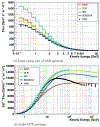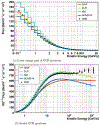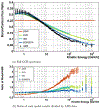Comparison of space radiation GCR models to recent AMS data
- PMID: 30100149
- PMCID: PMC8025833
- DOI: 10.1016/j.lssr.2018.05.003
Comparison of space radiation GCR models to recent AMS data
Abstract
This paper is the third in a series of comparisons of American (NASA) and Russian (ROSCOSMOS) space radiation calculations. The present work focuses on calculation of fluxes of galactic cosmic rays (GCR), which are a constant source of radiation that constitutes one of the major hazards during deep space exploration missions for both astronauts/cosmonauts and hardware. In this work, commonly used GCR models are compared with recently published measurements of cosmic ray Hydrogen, Helium, and the Boron-to-Carbon ratio from the Alpha Magnetic Spectrometer (AMS). All of the models were developed and calibrated prior to the publication of the AMS data; therefore this an opportunity to validate the models against an independent data set.
Keywords: Alpha magnetic spectrometer; Galactic cosmic rays; Space radiation.
Published by Elsevier Ltd.
Figures





References
-
- Aguilar M, et al., 2015. Precision measurement of the proton flux in primary cosmic rays from rigidity 1 GV to 1.8 TV with the alpha magnetic spectrometer on the international space station. Phys. Rev. Lett 114, 171103. - PubMed
-
- Aguilar M, et al., 2015a. Precision measurement of the helium flux in primary cosmic rays of rigidities 1.9 GV to 3 TV with the alpha magnetic spectrometer on the international space station. Phys. Rev. Lett 115, 211101. - PubMed
-
- Aguilar M, et al., 2016. Precision measurement of the boron to carbon flux ratio in cosmic rays from 1.9 GV to 2.6 TV with the alpha magnetic spectrometer on the international space station. Phys. Rev. Lett 117, 231102. - PubMed
-
- Clette F, Lefvre L, 2016. The New Sunspot Number: assembling all corrections. Solar Phys. 291, 2629–2651.
-
- International Standardization Organization (ISO), 2004. Space environment (natural and artificial) - galactic cosmic ray model. ISO 15390.
Publication types
MeSH terms
Grants and funding
LinkOut - more resources
Full Text Sources
Other Literature Sources

